Indice - Table of contents
New Stuff[hide]
Reportes: From The St... : Cubadisco 2...
Fotos: Tom Ehrlich
Staff: Kristina Lim
Musicos: Juan Formell
Musicos: Yordamis Megret Planes
Musicos: Yasser Morejón Pino
Musicos: José Luis "Changuito" Quintana...
Musicos: Dennis Nicles Cobas
Fotos: Eli Silva
Grupos: Ritmo Oriental : 1988 - Vol. IX - 30 a...
Musicos: Rafael Paseiro Monzón
Musicos: Jiovanni Cofiño Sánchez
Fotos: Tom Ehrlich : 2024 Monterey Jazz, P...
Resenas: Vacilón Santiaguero (Circle 9 ...
Photos of the Day [hide]
The Roots of Timba, Pt. III - 1986
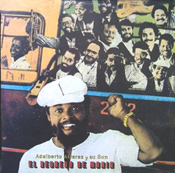 January: Adalberto Alvarez released his second album, El regreso de María. Like Formell, the young Adalberto was very much aware of the concept of "the album" as an artistic whole rather than just a collection of songs. With the complex multi-tempo title track [source] he goes a step further, connecting this album lyrically to the previous one, which began with Esperando que vuelva María. The middle part of the excerpt also contains another important foreshadowing of timba -- the bomba sicá rhythm, which returns later at the faster tempo in a great section featuring extended pregones by all three singers: Héctor Wedderbron, Félix Baloy, and Narciso Guanchi.
January: Adalberto Alvarez released his second album, El regreso de María. Like Formell, the young Adalberto was very much aware of the concept of "the album" as an artistic whole rather than just a collection of songs. With the complex multi-tempo title track [source] he goes a step further, connecting this album lyrically to the previous one, which began with Esperando que vuelva María. The middle part of the excerpt also contains another important foreshadowing of timba -- the bomba sicá rhythm, which returns later at the faster tempo in a great section featuring extended pregones by all three singers: Héctor Wedderbron, Félix Baloy, and Narciso Guanchi.
The cover art is a reference to the double entendre-laden closing track, Lo que me pasó en la guagua [source], the first of another great pair of Adalberto songs, its counterpart coming in 1990 with Si la guagua está llena. Calixto Oviedo is in fine form here, hinting at the innovative hihat style that he'd take to great heighths with NG La Banda in the 90s.
Another of the album's best tracks is the original version of Adalberto's often-covered Soy la rumba [write EGREM], later the opening track of the popular La rumba soy yo production of the 2000s.
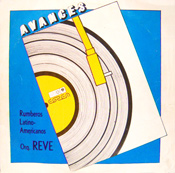 Revé's Rumberos latinoamericanos was the second in a string of 8 classic albums. After 1982's landmark Elio Revé y su ritmo changüí, Revé suffered another mass exodus of musicians, but he replaced them quickly and released an album that was almost as inspired and much better executed and recorded than its historic predecessor. The mystery bassist was replaced by the equally brilliant Pipo Noroña, and the new musical director/pianist was the great Juan Carlos Alfonso. The trombonists are much tighter and more in-tune. Félix Baloy, the only lead singer on the 1982 LP, was replaced by a trio of great vocalists that would stay together for 4 albums. Héctor Valentín, William "El Padrino" Esquivel, and Ricardo "Alfonsito" Alfonso.
Revé's Rumberos latinoamericanos was the second in a string of 8 classic albums. After 1982's landmark Elio Revé y su ritmo changüí, Revé suffered another mass exodus of musicians, but he replaced them quickly and released an album that was almost as inspired and much better executed and recorded than its historic predecessor. The mystery bassist was replaced by the equally brilliant Pipo Noroña, and the new musical director/pianist was the great Juan Carlos Alfonso. The trombonists are much tighter and more in-tune. Félix Baloy, the only lead singer on the 1982 LP, was replaced by a trio of great vocalists that would stay together for 4 albums. Héctor Valentín, William "El Padrino" Esquivel, and Ricardo "Alfonsito" Alfonso.
Valentín had a huge hit with the opening track Ruñidera [source], and also sings lead on the title track [source], JC Alfonso's first of several brilliant forays into the new subgenre that I call "orchestrated rumba" -- traditional guaguancó vocals and drums, with no bass or piano tumbaos, but with bold, almost symphonic instrumental accompaniment -- a style that was already being popularized by Los Van Van (De la Habana a Matanzas) and Irakere (Ese atrevimiento), and that continues to be used in the timba era, a notable example being Manolito's Ven ven siroco ven. All of these songs eventually morph into full band dance tracks, and Rumberos latinoamericanos is no exception, with El Padrino taking over with a brilliant series of pregones that will remind timba fans of El Indio's similar historical litany on Llegó la música cubana.
El Padrino's biggest hit from this album was Changüí campanero [source], with another creative introduction from arranger Juan Carlos Alfonso. From a timba perspective, however, the most creative aspect of the arrangement is this early precursor of the "pedal gear" that we'll be covering in detail in Volume III. Padrino also sings Tan linda [write EGREM], containing the album's most overt changüí influences. The cuerpo has many quotes from Pastorita guararey [source], and the breakdown briefly goes to almost pure changüí.
The third new singer, Alfonsito, has only one song on this album, but it was one of the biggest hits of 1986, Yo sé que tú sabes que yo sé [source]. Alfonsito's singing style had a huge influence on the next generation, as did the breakdowns in this great arrangement.
There are no boleros or filler tracks on this album -- every song was a hit and the band became the rage in Havana, earning it the apodo "La explosión del momento" that inspired the title of the third album the next year.
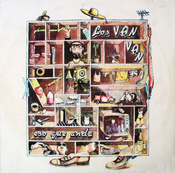 Los Van Van's experimentation with synthesizers came to the forefront on Eso que anda. The use of the synth in Cuban music falls into three categories:
Los Van Van's experimentation with synthesizers came to the forefront on Eso que anda. The use of the synth in Cuban music falls into three categories:
Special Effects -- for the purpose of sounding modern. Ironically, almost all of the tracks that used it would sound more modern today without the cutting-edge technology of 1986, as you can hear by comparing the first part of this clip from the title track to the tasteful acoustic orchestration that follows it. [source for all audio clips].
Electronic Percussion -- Changuito himself has reportedly expressed a certain distaste for synthesized percussion, which has mostly, but not completely, fallen out of favor. The problem of course is that the synth, especially the synths of the 80s, can't respond as expressively as a real timbal or tom tom. Fortunately, LVV never used a much more destructive aspect of drum machines - the sequencer. Cuban music depends heavily on subtle, and not so subtle, changes in tempo and time feel -- changes which are completely defeated by the use of sequencers, as a trip to hear the cut-rate entertainment at most modern Miami nightclubs will depressingly confirm.
The Synth as an Instrument unto itself -- When the synthesizer is used to create a new keyboard instrument rather than an emulation of an acoustic one, the results can be magical. For example, the Hammond B3 organ was a primitive attempt at synthesis that went awry. Ironically, the failure of tubes and other forms of analog technology to reproduce an acoustic organ resulted in a new sound that became an end in itself. The same is true of the electric guitar. B.B. King's Gibson 335 has a warm and profoundly expressive timbre that no acoustic guitar could ever produce.
In this third category, some of LVV's experiments have stood the test of time admirably. Pupy's Y ya tu campana no suena uses a funky synth patch that locks in beautifully with Changuito's acoustic percussion. Later in the same excerpt, a completely different timbre works well for the dissonant rising harmonies that foreshadow Boris Luna's brilliant synth work behind the second Mayito on Ay dios, ampárame [source]. (As an aside, it's also interesting to note the first Mayito's use of the word timba near the end of the clip: traigo mi timba caliente pa' que lo goce mi gente).
No es fácil is another successful example of a funky keyboard synth creating a rhythm feel that would be impossible on an acoustic instrument, although I'd prefer to hear it combined with acoustic percussion.
Orchestration aside, Eso que anda has plenty of great singing and songwriting. Canta la ceiba, baila la palma real has a unique harmonic hook in the cuerpo before returning to the well for more of that addictive 4-chord progression we mentioned earlier - this time leaning heavily towards the bVII interpretation.
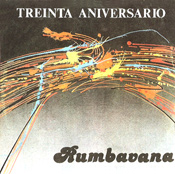 There were no synthesizers on Rumbavana's Treinta aniversario, a group which stuck to their traditional roots and maintained their popularity with pure adrenaline. Even here, however, in more aggressive songs like the scalding hot cover of La rumba está buena [write EGREM] there are tell-tale signs of modernization, such as the kick drum, the contracampana, the piano breakdown, and the dual coro sections.
There were no synthesizers on Rumbavana's Treinta aniversario, a group which stuck to their traditional roots and maintained their popularity with pure adrenaline. Even here, however, in more aggressive songs like the scalding hot cover of La rumba está buena [write EGREM] there are tell-tale signs of modernization, such as the kick drum, the contracampana, the piano breakdown, and the dual coro sections.
Many of the songs, like Chappottín's Que se fuñan, are from the traditional conjunto repertoire, but as always, Joseíto González added original compositions such as Soy cubano con razón [write EGREM].
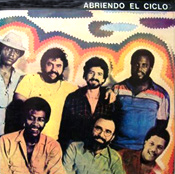 El Tosco, the future founder of NG La Banda, remained in Irakere until 1988, but created an experimental studio band on the side called Nueva Generación. They made four albums before shortening "Nueva Generación" to NG. In spite of its title, "Opening the Cycle", Abriendo el ciclo, appears to be the third.
El Tosco, the future founder of NG La Banda, remained in Irakere until 1988, but created an experimental studio band on the side called Nueva Generación. They made four albums before shortening "Nueva Generación" to NG. In spite of its title, "Opening the Cycle", Abriendo el ciclo, appears to be the third.
The first two LPs were entirely instrumental jazz, but Abriendo el ciclo [source] began to add vocals. The album was never reissued but the title track can be found on an interesting compilation that also contains the only reissues of the full version of the timba classic Qué viva Changó, and Manolín's songwriting debut, Vuela paloma.
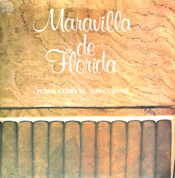 Maravillas de Florida: Puros como el son cubano -- Two of the tracks match tracks listed as having been recorded in December, 1986 on the Cuban Gold 5 compilation - the LP was released in early 1987. Préstame tu mujer (or Présteme su mujer) [source] has a nice "pedal" gear, breaking down to just güiro, Manolito's piano and the bass pedaling on the ponche (the same rhythm that NG's Arango would later use for his bass slides).
Maravillas de Florida: Puros como el son cubano -- Two of the tracks match tracks listed as having been recorded in December, 1986 on the Cuban Gold 5 compilation - the LP was released in early 1987. Préstame tu mujer (or Présteme su mujer) [source] has a nice "pedal" gear, breaking down to just güiro, Manolito's piano and the bass pedaling on the ponche (the same rhythm that NG's Arango would later use for his bass slides).
 Manolito's already-mature arranging abilities are showcased in El muerto [write EGREM]. This one has the bass sliding, but on the downbeat. Manolito also makes an impressive entry into the field of orchestrated guaguancós with Historia de un amigo enamorado, and on Pregonando flores voy, he creates the template for the piano tumbao to the timba anthem Yo no me parezco a nadie. Two more brilliant reasons to write EGREM are Oye bien guaguero and Qué gente caballero qué gente.
Manolito's already-mature arranging abilities are showcased in El muerto [write EGREM]. This one has the bass sliding, but on the downbeat. Manolito also makes an impressive entry into the field of orchestrated guaguancós with Historia de un amigo enamorado, and on Pregonando flores voy, he creates the template for the piano tumbao to the timba anthem Yo no me parezco a nadie. Two more brilliant reasons to write EGREM are Oye bien guaguero and Qué gente caballero qué gente.

















